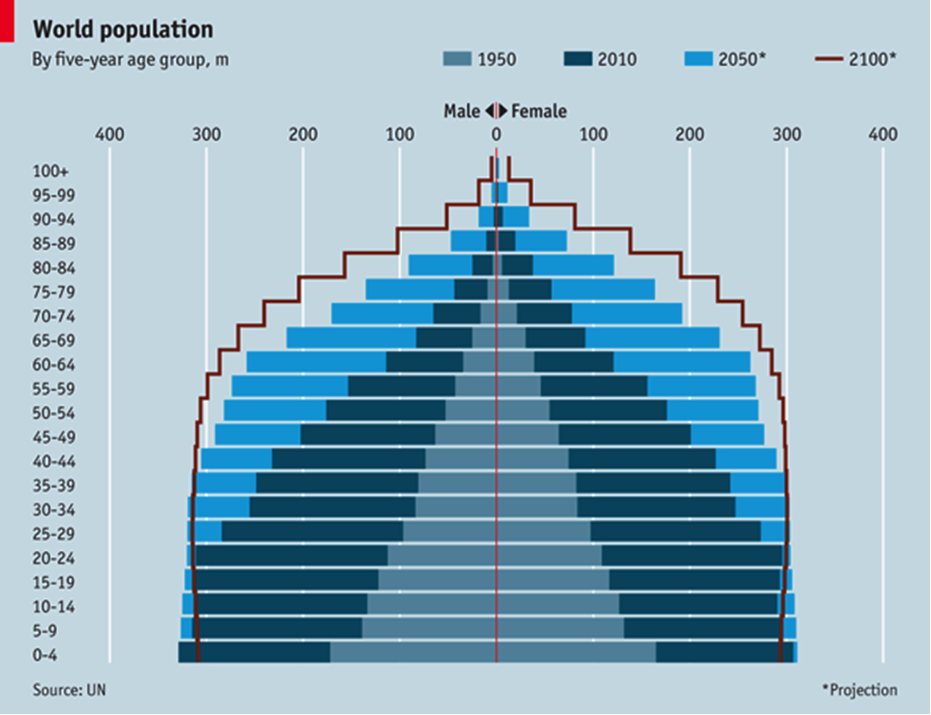Demography, Destiny & Demographic Cliffs
It has been said that “demography is destiny” suggesting that at some level basic facts – like the distribution of the population in different age groups – are key determinants of what happens to a given culture, country or even the world. That having been said, it is well known that the “population is aging” and some have argued that the impact of aging on the world will ultimately be as big as the development of agriculture or the Industrial Revolution. I agree with this assessment and would add that aging is happening much faster and that we can see it coming in comparison the rise of agriculture and industrialization.
Countries age for two basic reasons: 1) fewer children being born per woman, and 2) people living longer. These two factors also operate to determine the total population of a given country and the world as well. The chart below shows world population pyramids starting in 1950 with projects to 2100.
In 1950 the relative number of young people was far greater than older people. The so-called pyramid then gets progressively “squared” by 2010 and beyond. This chart also projects total world population to be in the 9-10 billion range in 2010, it is currently about 7 billion.
China’s 1 Child Cliff
In the 1970s China took some pretty drastic population control measures including a strictly enforced 1 child policy. The rationale was to avoid famines. The policy has “worked” but now China’s population is rapidly aging and in fact the population of China is also projected to decline and population experts in China believe the 1 child policy needs to be reversed. The chart below shows the projections for China. The solid red line is the best estimate for what will happen this century with various high and low projections bracketing it. Subsequent charts for other countries follow the same format.
The impact of both an older population with fewer workers for every retiree and less total population is uncharted territory especially for a developing country like China. However, several more advanced countries like Japan and to a lesser extent Germany (and much of the rest of Western Europe) are already headed in this direction or at least headed to stagnating populations with a higher average age and fewer workers per old person.
In terms of both total population and the ratio of old people to workers, the US is relatively well off compared to China, Japan and most other developed countries. The reasons for this are more babies per woman and immigration.
Uncharted Territory
Population is a topic that leads to all sorts of discussion and debates:
- What are the ecological costs of increased population and what is sustainable?
- How aggressive should specific countries and the world in general be in promoting birth control and lower population growth?
- If there are fewer workers per old person, how will old age pension systems and medical care be funded? This is a topic in the US, but it is also a topic essentially everywhere. The relative good news for the US also points out one advantage of liberal immigration policies – fewer young people to pay the bills.
- Should the retirement age be raised?
- What will the psychology of an older world be like? Young people take chances and roll the dice on all sorts of things while older people tend to be more risk averse and seek “certainty”. Will the aging population lead to less economic growth as a smaller faction of the world decides to “go for it”?
Who knows how all of this will play out, but if the phrase “demography is destiny” is a truism, it is likely to be especially true over the next 50 or so years. And, we can see at least some potential demographic cliffs coming.
This entry was posted on Wednesday, January 21st, 2015 at 4:34 am and is filed under Current Events. You can follow any responses to this entry through the RSS 2.0 feed. You can leave a response, or trackback from your own site.





